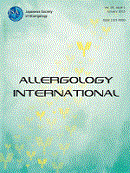Volume 59, Issue 3
Displaying 1-12 of 12 articles from this issue
- |<
- <
- 1
- >
- >|
REVIEW ARTICLE
-
2010 Volume 59 Issue 3 Pages 233-238
Published: 2010
Released on J-STAGE: September 09, 2010
Download PDF (1237K) -
2010 Volume 59 Issue 3 Pages 239-245
Published: 2010
Released on J-STAGE: September 09, 2010
Download PDF (754K) -
2010 Volume 59 Issue 3 Pages 247-256
Published: 2010
Released on J-STAGE: September 09, 2010
Download PDF (575K) -
2010 Volume 59 Issue 3 Pages 257-265
Published: 2010
Released on J-STAGE: September 09, 2010
Download PDF (209K)
ORIGINAL ARTICLE
-
2010 Volume 59 Issue 3 Pages 267-275
Published: 2010
Released on J-STAGE: September 09, 2010
Download PDF (498K) -
2010 Volume 59 Issue 3 Pages 277-284
Published: 2010
Released on J-STAGE: September 09, 2010
Download PDF (692K) -
2010 Volume 59 Issue 3 Pages 285-293
Published: 2010
Released on J-STAGE: September 09, 2010
Download PDF (434K) -
2010 Volume 59 Issue 3 Pages 295-304
Published: 2010
Released on J-STAGE: September 09, 2010
Download PDF (792K) -
2010 Volume 59 Issue 3 Pages 305-308
Published: 2010
Released on J-STAGE: September 09, 2010
Download PDF (175K)
CASE REPORT
-
2010 Volume 59 Issue 3 Pages 309-312
Published: 2010
Released on J-STAGE: September 09, 2010
Download PDF (381K)
SHORT COMMUNICATION
-
2010 Volume 59 Issue 3 Pages 313-319
Published: 2010
Released on J-STAGE: September 09, 2010
Download PDF (446K)
LETTER TO THE EDITOR
-
2010 Volume 59 Issue 3 Pages 321-322
Published: 2010
Released on J-STAGE: September 09, 2010
Download PDF (129K)
- |<
- <
- 1
- >
- >|
